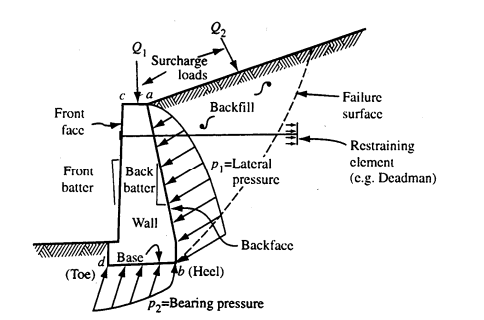A retaining wall is constructed after excavation or filling an embankment to provide support, preventing soil from eroding, or collapsing. Various factors affect the integrity of retaining walls, such as lateral earth pressure, and poor drainage. These factors can be managed by seeking the professional advice of a geotechnical engineer.

The most commonly used retaining walls include gravity, semi-gravity and cantilever. Gravity walls use self-weight to resist lateral earth pressures, semi-gravity use self-weight, vertical soil components, and weight above footing as well as steel reinforcement, and cantilever use the concrete base or footings to hold the wall and resist overturning or sliding by lateral earth pressures. The nature of the soil is crucial when constructing a retaining wall. The basic parameters of the soil include unit weight, angle of friction and cohesion. The design of retaining walls depends on the basic soil parameters, lateral pressure, and individual component strength. Common materials used for retaining walls include timber, stone, brick, and concrete.
Earth Retaining Structures
Earth retaining structures are constructed to hold back soil and maintain a difference in the elevation of ground surface. It is usually built to withstand the forces exerted by the retained ground or to transmit forces safely to the foundation.
BHM Geotechnical is a geotechnical engineering and environmental firm.
We have the expertise and resources to perform technical analysis and overcome complex challenges to do so. We provide an accurate geotechnical and environmental assessment to ensure our clients have more clarity. BHM can provide assistance in many ways such as 2D & 3D complex modelling & analysis, assessment of the bearing capacity, foundation and trench stability, hydraulic conductivity and more.
Factors to Consider When Building a Retaining Wall
There are several factors that must be considered when designing or building a retaining wall, some of these factors include easements, property boundaries, underground services as well as the surface topography. It is important to consider surcharge load, drainage patterns, and excess soil issues if the wall is on a slope. Water behind the retaining wall should drain in such a way as to avoid the build-up of water pressure behind the wall and/or the disturbance of neighbouring structures or land. A gravity wall is specially built to resist pressure from behind and uses its own weight for this purpose. Here are some of the factors one should consider:
- A strong foundation is essential even for a retaining wall. It is important to assess the trench stability since the soil will exert a lot of pressure on the wall. Failing to do so can result in collapse of the wall and waste of time and money.
- Lateral Earth pressure that is exerted by the soil in the horizontal direction.
- Additional forces exerted by the Earth include surcharge load, earthquake load and water pressure.
- Active Earth pressure that occurs when the soil pushes against the wall so as to tilt it.
- Passive Earth pressure also plays a major factor and is something that occurs when the wall is pushed into the soil. This is also referred to as the lateral bearing capacity.
Frequently Asked Questions
- What is Lateral earth pressure?
This is the pressure that the soil exerts in the horizontal direction. - What is Lateral bearing capacity?
This is the capacity of the soil to support the loads applied in the horizontal direction - What are anchors used for?
This type of wall will usually have a ‘T’ anchor extending back into the slope and into the Earth. It is specially designed to resist pressure. - What is a gravity retaining wall?
This type of wall relies on the walls self-weight to ensure stability and as results will likely use significant amount of concrete - What is a Cantilever retaining wall?
This type of wall is built from reinforced concrete and will consist of a horizontal footing and vertical stem wall. - What is surcharge loading?
Surcharge loading is the vertical pressure applied to the ground surface in the vicinity of a retaining wall.
This page is not intended to be a substitute for professional geotechnical advice and should not be relied on as geotechnical advice by individuals or other professionals to make site-specific decisions. Always seek advice from a professional geotechnical engineer.